ON NOVEMBER 11, 1989, Nirvana, along with grunge compatriots TAD, played West Berlin. What might have unfolded as an ordinary show was however, overshadowed by a fairly seismic event that had occurred two days prior. The Berlin Wall, the line that had divided East and West for nearly three decades, had unexpectedly and triumphantly been breached. “There was a line of Trabant—East German cars—40 kilometers long leaving East Germany going into West Germany,” TAD bassist Kurt Danielson recalls. “…And we played [West Berlin.] And so it was almost like a celebration. We didn’t really realize what was going on. We just knew that it was a historic event. But I think that shows you at that time, 1989…was a turning point in a lot of different ways.”
Bruce Pavitt’s Experiencing Nirvana: Grunge in Europe, 1989 covers the final eight days of the TAD/Nirvana 1989 European tour, beginning in Rome where Kurt Cobain had an emotional meltdown, to a triumphant finale at London’s Astoria Theater. The photo-journal is not only a tribute to Nirvana, but also to Pavitt’s enduring vision for independent music, for musicians and their fans and for outsiders shaking up the system.
Indeed, Pavitt’s storied career has unfurled as a sustained and at times combative challenge to the splintery status quo of the music industry. He began his Sub Pop record label—first as a fanzine, then as a radio show and newspaper column—as a vehicle for championing independent music. In 1988, he joined forces with fellow DJ Jonathan Poneman to turn Sub Pop into a full-time venture. After writing about independent music scenes around the country, Pavitt saw an opportunity to promote a new weird, heavy punk/metal hybrid happening in his own backyard. But he needed a name to describe this music.
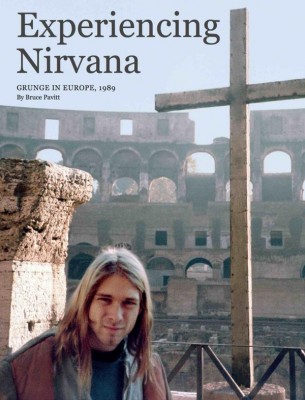 That came in April of 1988, when he used the word “grunge” in an ad promoting his label. Within a few months, the word entered and soon embedded itself in the Seattle music community to describe the new crop of heavy Sub Pop bands. The label would showcase this early sound through three flagship emissaries: Mudhoney, TAD, and Nirvana.
That came in April of 1988, when he used the word “grunge” in an ad promoting his label. Within a few months, the word entered and soon embedded itself in the Seattle music community to describe the new crop of heavy Sub Pop bands. The label would showcase this early sound through three flagship emissaries: Mudhoney, TAD, and Nirvana.
Of the three, Nirvana lagged as the least developed, both musically and identity-wise. The band caught Poneman’s attention when producer Jack Endino forwarded him a demo tape in early ’88 of the Kurt Cobain-led trio, which failed to induce much enthusiasm in Pavitt. “The demo came in and I remember [Mudhoney’s] Mark [Arm] and I both looked at each other,” Pavitt recalls. “We thought the arrangements over a lot of tracks were a little too busy…. when Jon and I first saw them at the Central [Tavern] in April of ’88—and I discussed that in the book—and that’s kind of a little known fact about the band is their first appearance in Seattle was actually at the Central—at this little showcase that they did for us that nobody really showed up for. In listening to their whole set, it’s like [“Love Buzz”] was the only [song] that really jumped out, and it was a cover. But, the…hypnotic feel of that was kind of an indicator of some of their direction in songwriting.”
In October of 1989, Sub Pop sent TAD and Nirvana off on a six week tour of Europe—beginning and ending in the UK—to promote their debut records. The bands would meet up with Mudhoney in London that December. Mudhoney, then more popular than Nirvana, had already blazed a trail through Europe with their jagged assault of garage-inspired abandon. Nirvana, however, took a while to find their voice. “In the case of Mudhoney,” says British music journalist Keith Cameron, then with Sounds, “I honestly believe that they probably didn’t really have very many baby steps. They had their shit together from the very beginning. Nirvana, I’ve come to understand, really got it together pretty much on that tour.”
Experience Nirvana picks up the action in Rome on November 27, where an emotionally fried Cobain climbed the speaker stacks during a show and threatened to jump. The emotionally-punishing realities of touring had withered the Nirvana frontman to something of a breaking point after spending five cramped weeks traveling with his bandmates from town to town in a dank, squalid van. Poneman grabbed Cobain and took him on a tour of Rome, providing the Nirvana singer a chance to calm down. Some of the book’s finest photos were taken during this time. “Well, I went through the photos,” says Pavitt, “and there were a couple of exceptional shots—in particular, Kurt standing in front of the cross at the [Roman] Colosseum. It just seemed rather iconic and epic in scope and I thought, ‘I really need to share this.’”
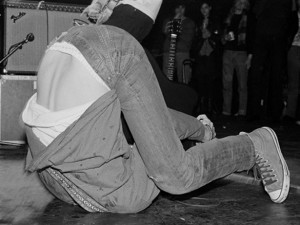 Pavitt’s photos capture the bands’ odyssey through Germany and France, leading up to the London show. Despite coming from a then-unknown backwater town, Pavitt’s shots reveal an unmistakable confidence in both the musicians and their Sub Pop benefactors. It’s as if the Seattle bands knew they were going to kick ass in Europe. “Well, I gotta say,” Pavitt recalls, “that the roots of that [confidence] would have to be in watching Mark Arm get on stage….and he was the one who was really channeling Iggy Pop. His stage presence was just absolutely phenomenal. I’d rarely ever seen anything like it. And I think he was a huge influence on [Nirvana] and TAD as well. He kind of like defined the vibe. Like, ‘we’re gonna just go out there and even if we trip over our shoelaces, it doesn’t matter. We’re going to completely and totally rock out. And consequently the crowd’s gonna go insane.’ So after seeing some of these Mudhoney shows, you couldn’t help but go, ‘Oh my God, this is amazing.’’
Pavitt’s photos capture the bands’ odyssey through Germany and France, leading up to the London show. Despite coming from a then-unknown backwater town, Pavitt’s shots reveal an unmistakable confidence in both the musicians and their Sub Pop benefactors. It’s as if the Seattle bands knew they were going to kick ass in Europe. “Well, I gotta say,” Pavitt recalls, “that the roots of that [confidence] would have to be in watching Mark Arm get on stage….and he was the one who was really channeling Iggy Pop. His stage presence was just absolutely phenomenal. I’d rarely ever seen anything like it. And I think he was a huge influence on [Nirvana] and TAD as well. He kind of like defined the vibe. Like, ‘we’re gonna just go out there and even if we trip over our shoelaces, it doesn’t matter. We’re going to completely and totally rock out. And consequently the crowd’s gonna go insane.’ So after seeing some of these Mudhoney shows, you couldn’t help but go, ‘Oh my God, this is amazing.’’
“You know, I think we probably put on a brave face,” Arm counters. “I’m sure we were quite intimidated, but you just gotta get beyond that. If you play live, the last thing people want to watch is a band that’s visibly intimidated. A crowd will turn on you in a split second.”
Experience Nirvana also provides another important aspect of that band’s early life: Nirvana as an independent act on an independent label. Pavitt’s words and photos effectively present this other side of Nirvana, to fans only familiar with the post-Nevermind version of the band. Nirvana and their Seattle brethren supported one another, referring to their peers as “brothers,” and even wearing each other’s t-shirts. In the book, you’ll see Danielson sporting a Nirvana tee and Arm wearing a Fluid shirt (a Sub Pop band from Denver.) “I always looked at the indie underground scene as a federation of tribes networking and supporting each other,” says Pavitt. “It was all about supporting each other and then supporting bands from other tribes. Like you’ll see Kurt Danielson wearing a Sonic Youth t-shirt or Mark Arm wearing a Fluid shirt or Matt [Lukin from Mudhoney] wearing a Big Chief shirt. And there’s a real deep sense of camaraderie you see when bands are working the indie circuit, that you don’t necessarily see in the big leagues. And I think the book kind of captures that vibe pretty well.”
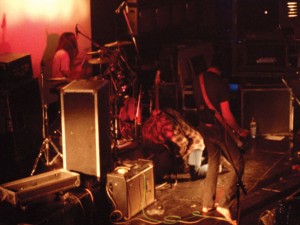 “Nirvana were our brothers,” says Danielson. “And Bruce and Jon were our brothers. And when you are brothers, you don’t think in terms of yourself. You think in terms of others, and so, when you wore [a fellow band’s] shirt, you were proud to do it. It was an honor. You were wearing your brother’s shirt.”
“Nirvana were our brothers,” says Danielson. “And Bruce and Jon were our brothers. And when you are brothers, you don’t think in terms of yourself. You think in terms of others, and so, when you wore [a fellow band’s] shirt, you were proud to do it. It was an honor. You were wearing your brother’s shirt.”
That sense of brotherhood, which seemed to come naturally to the Seattle scene, did not necessarily carry over to the entire indie music community. With most bands, in fact, the motivation remained one of self-interest. “I’ve never understood that,” says Danielson. “I’ve seen that elsewhere, too, in other towns, where you’ll meet a friend of yours who’s in one band, and you’ll be on the street, let’s say on the Lower East Side in New York. Somebody from another New York band walks up, and you’re friends with them too, but the New York guys aren’t friends with each other. As a matter of fact, they’re enemies. And [that] was hard for me to grasp.”
“I remember one time kind of early on being in Italy,” says Arm, “and talking to some guy who was in a band. And he’s like, ‘You’re wearing t-shirts from other bands. I would never do that. I would just be proud of my own band and only wear my own band’s t-shirts.’ I thought, ‘that was kind of weirdly narcissistic.’”
The tour, and Pavitt’s book, concludes at a December 3 show with Mudhoney joining Nirvana and TAD at London’s Astoria Theater. Mudhoney was the obvious headliner, as they were the most popular band at the time. Nirvana would go on first, determined by a coin toss, with TAD following. This particular show, dubbed LameFest UK, would be the first time the Sub Pop bands would perform for the British music press, then the most influential in the world.
As per usual, Mudhoney killed. After they finished their set, TAD’s large-girthed front man Tad Doyle came on stage looking for action. He spotted Mudhoney drummer Dan Peters, and immediately picked him up and carried him to the edge of the stage. “He tossed me into the crowd,” Peters remembers. “Next thing I know I’m floating around on people. It was pretty funny.”
Arm noticed what was going on, and quickly reacted. “I just saw like people from TAD, Nirvana all like waiting in the wings,” he remembers. “And I’m going, ‘This is kind of unusual. This is weird. I’m gonna keep my eyes peeled and see what’s gonna go on.’ And they all came out and like started grabbing everybody, trying to throw ’em off stage. I just ducked under the drum riser.”
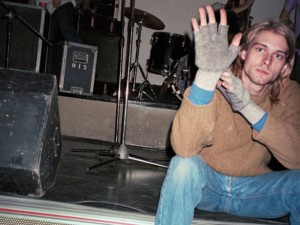 Nirvana’s presence was clearly a turning point for the band. As captured in Pavitt’s photos, the rabid crowd took in this rising group on its way to becoming a phenomenon. “The band’s grungy primal punk-pop had won over the jaded London crowd,” Pavitt writes in Experiencing Nirvana, “whose response was absolutely relentless. Mark Arm from Mudhoney looked on, speechless, as the band was about to dethrone his own.”
Nirvana’s presence was clearly a turning point for the band. As captured in Pavitt’s photos, the rabid crowd took in this rising group on its way to becoming a phenomenon. “The band’s grungy primal punk-pop had won over the jaded London crowd,” Pavitt writes in Experiencing Nirvana, “whose response was absolutely relentless. Mark Arm from Mudhoney looked on, speechless, as the band was about to dethrone his own.”
“In my mind, from that moment onward they were kind of their own entity,” says Keith Cameron, who was in attendance. “They seemed sort of removed from the other Sub Pop bands.”
Within two years of the Astoria performance, Nirvana released the seminal Nevermind, inciting the ’90s grunge revolution, with the Astoria show emerging as a watershed moment in the band’s career. That being said, the quality of Nirvana’s actual performance that night remains up for debate. “What’s really fascinating about that show,” says Nirvana biographer Everett True, who was also in attendance, “is you talk to anybody who saw Nirvana that night and they will give you a completely contradictory opinion about it. There’s some people there who swear it’s the worst show they ever saw. There’s some people there who swear it’s one of the best shows they ever saw, pretty much for the same reasons….They just absolutely trashed the stage—just cleared it completely….no amps, nothing anywhere. From my perspective it was just like…‘This band absolutely understands rock and roll. They totally get it. They totally understand about spontaneity and electricity and excitement and entertainment. Who gives a fuck what the songs are like?’”
“You know, it’s interesting, because I’ve read a few of the books out there and there’s been some critique of the show,” says Pavitt, “[that it] wasn’t very good… And I was like, ‘Wait a second, I was there.’ And I think what my photos really show…is the crowd reaction. I mean, every five seconds somebody was flying through the air. You cannot tell me that show did not go off. The proof is there. And then, some of [UK photographer] Steve Double’s shots [also in the book], where Kurt is three feet up in the air—just incredible stuff.”
“I think we had a great show,” Mudhoney drummer Dan Peters recalls. “TAD had a great show. Nirvana’s show was not that great, [however]. They were fraught with technical difficulties and gear malfunctions and breaking strings and they didn’t really get their momentum going. Of course, in hindsight, everybody [remembers] they blew everybody away and that it was the greatest show ever. But that’s not the way I remember it.”
“It seemed like there was this idea that Nirvana like blew everyone away,” says Arm, “but that only kind of came up after Nevermind blew up….We all remember that show watching Nirvana kind of flail on stage and like having a bunch of problems and not really playing all that well and kind of going, ‘Oh man, this is really kind of too bad, because they’re here in London and they’re kind of dying.’”
Ultimately, Experiencing Nirvana captures an important chapter in Nirvana’s career, as members of the indie tribe, where they supported other bands who in turn supported them. Nirvana never jettisoned those connections, even after they became famous. “We remember sitting around in a van in Europe,” says Doyle, “when nobody knew who the hell they were, and nobody knew who the hell we were. And we’re just having fun, just being in Europe together. And I remember sitting down with those guys [in Nirvana]—we’d jokingly say to each other, ‘Hey man, when you guys make it, don’t forget the little guys. Don’t forget your brothers.’ And holy crap, it happened to ’em. And they didn’t. They didn’t forget us.”
Postscript
At the beginning of the European tour, TAD and Nirvana were preparing to play for legendary British DJ John Peel.
“Both bands were scheduled to do Peel sessions at the BBC,” says Kurt Danielson. “And, when it came time for Nirvana to do that, Kurt was busy writing some lyrics on a piece of notebook paper with a pencil. And they were lyrics to ‘Polly.’ It was the first time they were gonna record a version of ‘Polly.’ This is before he recorded it for Nevermind, obviously….And Kurt never [had] actually written out the lyrics. What he would do, in general he would just cobble words together and sing them—he’d have the vocal phrasings worked out. He would sing any old words, as if he was reading out of the phone book….And then when it came [time] to record [the song], he’d figure out what he really wanted to say. Then he’d write ’em down and then that was that.”
Later, TAD and Nirvana decided to clean out their touring van. “The van was a complete pigsty,” Danielson remembers. “It was full of like empty vodka bottles and beer cans and empty brandy bottles from Hungary and all kinds of garbage. So we cleaned it out….and I found—crumpled up—Kurt’s lyrics for ‘Polly.’
“But I was tired and I wasn’t really thinking in terms of posterity or the future. I was just thinking, ‘Well, this is garbage. Let’s throw it away.’ And I did. And I’ve always thought, ‘Wow. I should have held on to that. That would have been a nice keepsake.’”

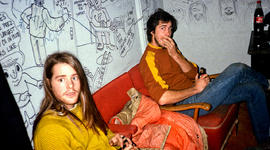


Pingback: Bruce Pavitt’s Experiencing Nirvana | the strangest tribe
I think this is one of the most important information for me.
And i’m glad reading your article. But should remark on some general things, The web
site style is great, the articles is really nice : D.
Good job, cheers
Hmm it looks like your blog ate my first comment (it was extremely long) so I guess I’ll just sum it up what I wrote and say, I’m thoroughly enjoying your blog.
I as well am an aspiring blog writer but I’m still new to everything.
Do you have any tips for beginner blog writers?
I’d really appreciate it.
Great items from you, man. I have remember your stuff previous to and you’re simply too wonderful.
I actually like what you have got right here, really like what
you’re saying and the best way through which you are saying it.
You make it entertaining and you still care for to keep it wise.
I can not wait to learn much more from you.
That is really a great website.
We stumbled over here different web page and thought I should check things out.
I like what I see so now i am following you. Look forward to looking over your web page repeatedly.